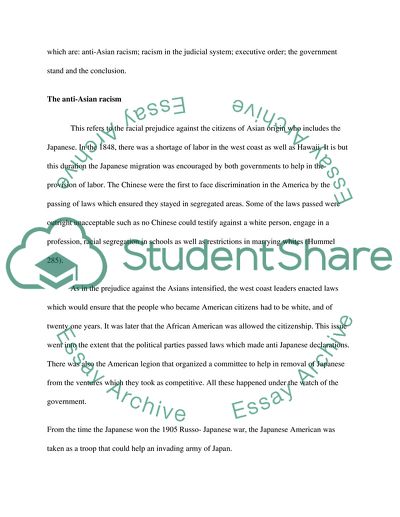Cite this document
(“What evidence is there of anti-Japanese racism prior to the US Research Paper”, n.d.)
What evidence is there of anti-Japanese racism prior to the US Research Paper. Retrieved from https://studentshare.org/sociology/1619633-what-evidence-is-there-of-anti-japanese-racism-prior-to-the-us-governments-decision-to-place-all-persons-of-japanese-ancestry-in-concentration-camps-and-evidence-that-this-anti-japanese-racism-played-an-important-part-in-the-decision
What evidence is there of anti-Japanese racism prior to the US Research Paper. Retrieved from https://studentshare.org/sociology/1619633-what-evidence-is-there-of-anti-japanese-racism-prior-to-the-us-governments-decision-to-place-all-persons-of-japanese-ancestry-in-concentration-camps-and-evidence-that-this-anti-japanese-racism-played-an-important-part-in-the-decision
(What Evidence Is There of Anti-Japanese Racism Prior to the US Research Paper)
What Evidence Is There of Anti-Japanese Racism Prior to the US Research Paper. https://studentshare.org/sociology/1619633-what-evidence-is-there-of-anti-japanese-racism-prior-to-the-us-governments-decision-to-place-all-persons-of-japanese-ancestry-in-concentration-camps-and-evidence-that-this-anti-japanese-racism-played-an-important-part-in-the-decision.
What Evidence Is There of Anti-Japanese Racism Prior to the US Research Paper. https://studentshare.org/sociology/1619633-what-evidence-is-there-of-anti-japanese-racism-prior-to-the-us-governments-decision-to-place-all-persons-of-japanese-ancestry-in-concentration-camps-and-evidence-that-this-anti-japanese-racism-played-an-important-part-in-the-decision.
“What Evidence Is There of Anti-Japanese Racism Prior to the US Research Paper”, n.d. https://studentshare.org/sociology/1619633-what-evidence-is-there-of-anti-japanese-racism-prior-to-the-us-governments-decision-to-place-all-persons-of-japanese-ancestry-in-concentration-camps-and-evidence-that-this-anti-japanese-racism-played-an-important-part-in-the-decision.


